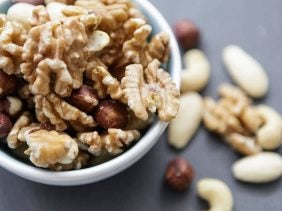Reverse Dieting – 5 tips to end your diet the right way and avoid the yo-yo effect!
 ©foodspring
©foodspring
Eat more, weigh less? Diet with a normal calorie intake and without the yoyo effect? Reverse dieting promises exactly that. We’ve taken a close look at the trend.
Reverse dieting is becoming increasingly popular in the fitness scene and among celebrities. The basic idea is that you maintain your weight with a normal calorie intake. Whether directly after a calorie-reduced diet or in everyday life, you’ll stay fit and in top shape.
Representative scientific studies on the trend are unfortunately still in short supply. Nevertheless, the diet concept follows a comprehensible logic and the positive experiences its fans report are also promising.
No matter what diet you follow or what you like to eat most: food should taste good and be fun. Always! In order to get or stay in top shape, it’s essential to eat what fits your goal.
Are you aiming for weight loss, muscle building, improving endurance, or simply eating a bit healthier? Our range of fitness food is specially tailored to any of your goals. Great taste, high-quality raw materials, and simple preparation are our guarantee.

discover our range of Fitness Food
What is reverse dieting?
There are two different definitions of reverse dieting. We’ll explain both, but will focus on the second definition as a successive increase in daily calorie intake.
Reverse dieting: Turn your day upside down
One definition is: dinner in the morning, lunch at noon, breakfast in the evening. The idea behind it is simple. You should consume the most energy in the morning and at noon because your body has time to burn more calories during the day. Overnight, your body concentrates on regeneration and recovery without having to spend energy for digestion.
A proper amount of carbohydrates, healthy fats, and protein should boost your metabolism in the morning and provide energy for the day. At lunchtime, you should have a light lunch with protein and fiber, and in the evening a small breakfast such as yogurt with muesli, a smoothie bowl, or an egg.
Sounds like it takes getting used to, but it can work. In the end, it always depends on the total calorie count; the right distribution of carbohydrates, protein, and fat; and your choice of food. Junk food and excess calories won’t bring you to your goals, even if you’re having dinner for breakfast.
Reverse dieting: Metabolic boost instead of starvation
The definition of reverse dieting as “the diet after your diet” is much more promising, but also more complex. Reverse dieting in this case means that you increase your daily calorie intake in a controlled manner to stimulate your metabolism.
This can help you to avoid yo-yo effects after a diet or to get a generally sluggish metabolic rate going again. By the end you’ll be back to your normal daily calorie intake.
This principle is based on the knowledge that with a low-calorie diet, your metabolism switches to an economy mode to restore homeostasis. Your body wants to keep all its processes in good balance, so if during a diet you permanently eat fewer calories than you consume, your body will gradually burn fewer and fewer calories. It switches to energy saving mode.
If you suddenly increase your energy intake after a diet, your body will prefer to store these unfamiliar calories as fat in order to be ready for another shortage of food. Here’s where the yo-yo effect comes in. Worst case, you gain even more weight than what you worked so hard to lose.
This is exactly where reverse dieting comes in. By increasing your daily calorie intake slowly and in a controlled manner, your metabolism is awakened from its energy-saving mode and brought back up to speed.
As you slowly increase your daily calorie intake, the food-induced thermogenesis and the efficiency of your metabolism will also increase. Instead of building up fat stores, your body burns the energy it has been supplied with.
In addition, more food automatically means that you are less hungry. On the one hand, this puts you in a good mood, and it also reduces the release of the hunger hormone leptin. Leptin slows down the metabolic rate and promotes the accumulation of fat deposits to save energy.
So that’s the theory. Experiences confirm the idea, but so far there aren’t any scientific studies proving its effects. We still think it’s worth trying!
Tip: Reverse dieting requires precise calorie counting. In our recipe database, you will find over 100 recipes where we’ve already done just that. Perfectly matched to your goals, of course.

discover our free Fitness Recipes
How reverse dieting works – 5 tips
Even if the scientific information on reverse dieting is still lacking, there’s enough sound nutritional know-how to maximize your chances of success. Try it out with these ideas!
#1 Increase calorie intake, but slowly
To slowly wake up your metabolism again, you need patience. As a guideline: Increase your daily calorie intake by 50-100 kcal per week.
Example:
If you ate 1800 kcal daily as part of your diet, you would eat 1850-1900 kcal daily in week 1 of your reverse diet, and 1900-1950 kcal in week 2. And so on. Continue this pattern until you have reached the total calorie consumption for weight maintenance.
Wie lange dein Reverse Dieting dauert, hängt also von deinem Defizit und deinem normalen täglichen Kalorienbedarf ab.
Tipp: Mit unserem kostenlosen Kalorienrechner kannst du deinen Kalorienbedarf für Gewichtserhalt ganz einfach errechnen.
How long you do this depends on your deficit and your normal daily calorie requirements.
Tip: With our free calorie calculator you can easily calculate your calorie requirements for weight maintenance.
#2 Healthy first
If you calculate your increased calorie intake in chocolate chips, we are sorry to disappoint you. Your diet should include healthy foods with a low glycemic index that will only slowly increase your insulin levels. This prevents cravings, hunger pangs, and storing food energy as fat cells.
Low GI foods include natural yogurt, green lentils, wholegrain rye bread, carrots, apples, and cashews.
#3 Mind your macros
With a well planned calorie-reduced diet you’ve calculated your macronutrient requirements anyway. Unless you radically change your lifestyle or exercise a lot more or a lot less, the percentage distribution of macronutrients can stay the same, especially in the first few weeks, as it was during the diet.
It’s best to use our free macronutrient calculator about every two weeks to check if your macronutrient distribution still fits your goal and activity level.
Your body fat percentage (BFP) shows you whether you’re on the right track. Calculate your body fat percentage at the beginning of the reverse diet and check it every two weeks. If it increases by more than 1%, check the adjustment of your calorie count and macros.
As a quick measure of rising BFP, increase the protein content in your diet minimally. Then minimize carbohydrates by the appropriate amount and suspend the increase in daily calories for a week.
If you have greatly increased your protein intake during your diet, about halfway through start to gradually shift your protein intake percentage in favor of some more carbs.
Tip: If it does have to be chocolate, look no further than our Extra Chocolate Protein Bars.

try an extra chocolatey protein bar
#4 Keep moving
Did you train to build, define, or lose weight? Then keep it up. If you change your training volume, no matter which direction, your calorie requirements will also change. . Consider you workout plan when planning your reverse dieting. Fitness trackers are helpful in determining your actual calorie expenditure. Especially with reverse dieting, the more accurate the better.
#5 Remember the bigger picture
The key to reverse dieting. In order for the successive increase in calories and for the whole concept to work, you need to follow your diet and exercise plan closely. The following parameters are particularly important:
- Your calorie intake at the end of the diet.
How high was your calorie deficit or how many calories did you eat per day before you decided to use reverse dieting? This number is the basis for your further plan. Write down your starting calorie intake and plan to increase it by 50-100 calories per week. This way you can see exactly how many weeks you need to reach your goal.
- How much do you really eat?
Track. Every. Calorie. Even the ones from the apple juice, or the latte macchiato. You’ll have exceeded 50-100 kcal faster than you think. Even an average sized apple has 50 kcal.
- How many calories do you really consume?
There can be worlds between calculated and actual calorie consumption. So track yours every day.
- How much do you weigh?
Weigh yourself every day to avoid falling back into old patterns over time without realizing it. But don’t go crazy if you ever have an extra 1 kg on the scale. Full glycogen stores or water retention – especially for women – can affect the number on the scale. Daily weight gain or weight loss fluctuations of 1 to 2 kg are completely normal for both women and men. Before you start, learn how to weigh yourself correctly.
Based on this information, you can always see if you’ve reached your daily goal and where you are on your way. After 3-4 weeks you will notice how well your metabolism can handle the extra energy and how much time you have to plan for reverse dieting until you reach your goal.
Sounds like a lot of work? It is. But if you can stay in shape and eat the way you want to in the long run, it’s definitely worth it.
Is it healthy?
To date, there is no scientifically proven knowledge about the health effects of reverse dieting. As with any diet, it’s also subject to the following: How healthy it ultimately is depends, among other things, on how you design your diet. Choose healthy fats, complex carbohydrates, high-quality proteins, and high-fiber foods.
Make sure you eat about the same amount every day. Distribute your meals evenly throughout the day to avoid insulin peaks and keep your blood sugar levels stable. This prevents cravings and helps burn fat.
Tip: In our free recipe database you will find over 300 healthy fitness recipes for your goal. We have calculated the number of calories, as well as amount of protein, carbohydrates, and fat in each recipe, so nothing stands in the way of your perfect reverse diet plan.
Who is it suitable for?
It’s suitable for anyone who wants to normalize their lifestyle after a calorie-reduced diet and avoid the yoyo effect. Also, if your weight loss plateaus during a diet, a reverse diet can get the metabolism going again.
After a definition phase or special competition nutrition, reverse dieting is a good way to return to normal eating habits without too much fat gain.
In general, tracking calories and knowing what you eat is great. However, being successful requires a high degree of precision. So after a diet, you have to invest a lot of time and energy in designing your diet again.
Calorie tracking as a compulsive act?
The permanent tracking of every single bite – required by reverse dieting and strict diets – can also take on compulsive features. In the end, nutrition should help you achieve your goals, but also be fun and healthy – for body, mind, and soul.
Documenting very precise macros and maybe even micros for a while can definitely help you to develop a better relationship to your diet, but it can also have the opposite effect and can cause you to struggle with your body image.
If the thoughts of calories and sugar content make you miss out on the occasional ice cream, a critical point has perhaps been reached. Be present with the process.
Reverse dieting – hit or miss?
Eat more and stay in shape? Sounds great at first. But reverse dieting also requires a lot of planning and discipline. We’ve compared some of the advantages and disadvantages of trying this concept out.
| Advantages | Disadvantages |
|
|
|
|
|
|
|
|
|
|
|
|
|
|
|
|
Summary
- Reverse dieting means increasing your calorie intake again gradually after a calorie-reduced diet.
- It can help to avoid the yo-yo effect and can be a first step towards a healthy change in diet.
- Reverse dieting can be a sensible solution when weight stagnates during a diet.
- It requires accurate recording of calorie intake and energy expenditure over a long period of time. This carries the risk of developing an unhealthy relationship with diet, exercise, and your own body.
- To date, there are no significant scientific studies available on the subject of reverse dieting.
Sources for this article
We at foodspring use only high-quality sources, including peer-reviewed studies, to support the facts within our articles. Read our editorial policy to learn more about how we fact-check and keep our content accurate, reliable, and trustworthy.
































